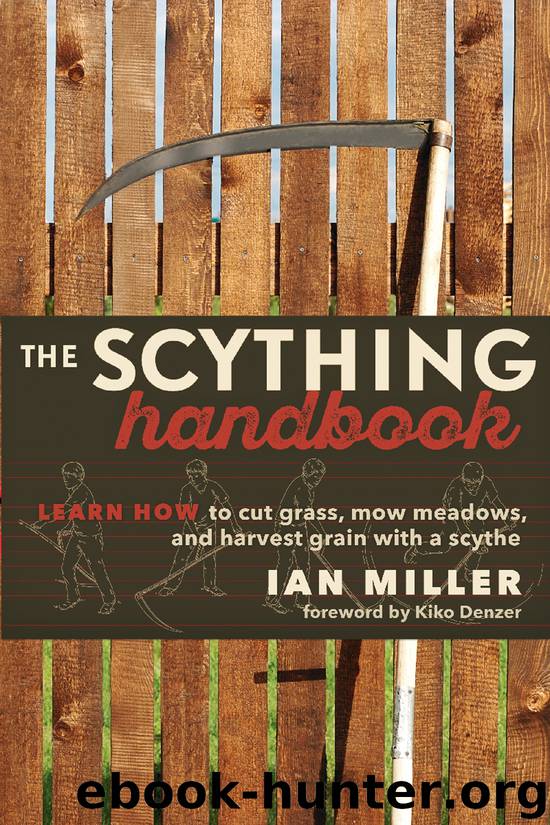The scything handbook : learn how to cut grass, mow meadows, and harvest grain with a scythe by Ian Miller

Author:Ian Miller
Language: eng
Format: epub
Publisher: New Society Publishers
Published: 2016-03-21T16:00:00+00:00
A stoker heats blade blanks in the blank forge using tongs.
DRAWING OUT THE BLADE These slabs of welded steel with forged tangs were then heated in the drawing forge almost all the way to the tang, then brought under the drawing hammer to be made into scythe blades. The tang (which had not been heated but was hot to the touch) was held with a cloth or glove in the left hand, and the piece was stabilized by holding it with tongs in the right hand. By passing the still glowing piece evenly under the hammer, the steel was drawn out to form the blade, while the portion that was to form the chine was left untouched at this point. This first phase of drawing out resulted in a piece that was about 1½ in (38 mm) wide and about ⅛ in (4 mm) thick all the way down to the point, excluding the first quarter of the length of the piece which was neither heated nor hammered at this stage.
When all the pieces had been through the first phase of drawing out, the drawing hammer’s face was honed for the next phase. The pieces were replaced in the forge to heat primarily their middle portions and then brought under the hammer again – this time flipped over with the chine-to-be on the left side and then quickly flipped over again between hammer strikes to ensure even thickness of the blade.
The blade was heated a third time at the point, and the point was then forged under the hammer as in the second phase: first upside down, then right side up. Finally, the blade was heated a fourth time at the tang so that the beard could be forged. The heels of the tang and the beard were often reinforced during this phase, either with a “stag’s tongue”– a finger-long, tapered rib parallel to the chine originating at the tang – or by simply forging the heel so that the material was less drawn out and thus stronger.
Download
This site does not store any files on its server. We only index and link to content provided by other sites. Please contact the content providers to delete copyright contents if any and email us, we'll remove relevant links or contents immediately.
Audition by Ryu Murakami(4093)
The Body: A Guide for Occupants by Bill Bryson(3791)
Adulting by Kelly Williams Brown(3663)
Housekeeping by Marilynne Robinson(3397)
Zero Waste Home by Bea Johnson(3286)
Be in a Treehouse by Pete Nelson(3207)
Seriously... I'm Kidding by Ellen DeGeneres(3098)
Better Homes and Gardens New Cookbook by Better Homes & Gardens(2950)
Barkskins by Annie Proulx(2877)
The Healing Self by Deepak Chopra(2792)
Hedgerow by John Wright(2772)
The Life-Changing Magic Of Tidying Up- The Japanese Art Of Decluttering And Organizing (v5.0) by Marie Kondo(2742)
Spark Joy by Marie Kondo(2671)
The Genius of Japanese Carpentry by Azby Brown(2602)
The Cellar by Natasha Preston(2592)
Work Clean by Dan Charnas(2557)
120 Days of Sodom by Marquis de Sade(2428)
The Book of Numbers by Peter Bentley(2400)
A Monk's Guide to a Clean House and Mind by Shoukei Matsumoto(2400)
